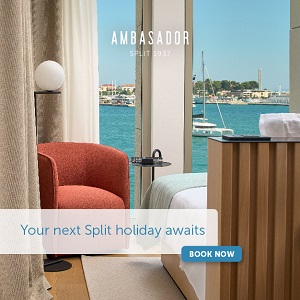Market vs. Social Distance? Đurđevac says: Market With Social Distance!
May 8, 2020 - Markets are sources for many people when it comes to fresh vegetables, fruits, milk, cheese, and much more. So, how is the market in Đurđevac coping in the second week of reopening?
Visiting markets is a part of the weekly, maybe even daily routine for a large number of people. While many markets needed to close their gates due to measures, people were left not only without fresh food but maybe without the familiar faces of their favorite sellers.
The market in Đurđevac used to be open every Thursday, and as one of the locals said: "This must have been difficult for them during this period of the pandemic, especially because the beginning of spring brings many more customers that buy plants for their personal gardens."
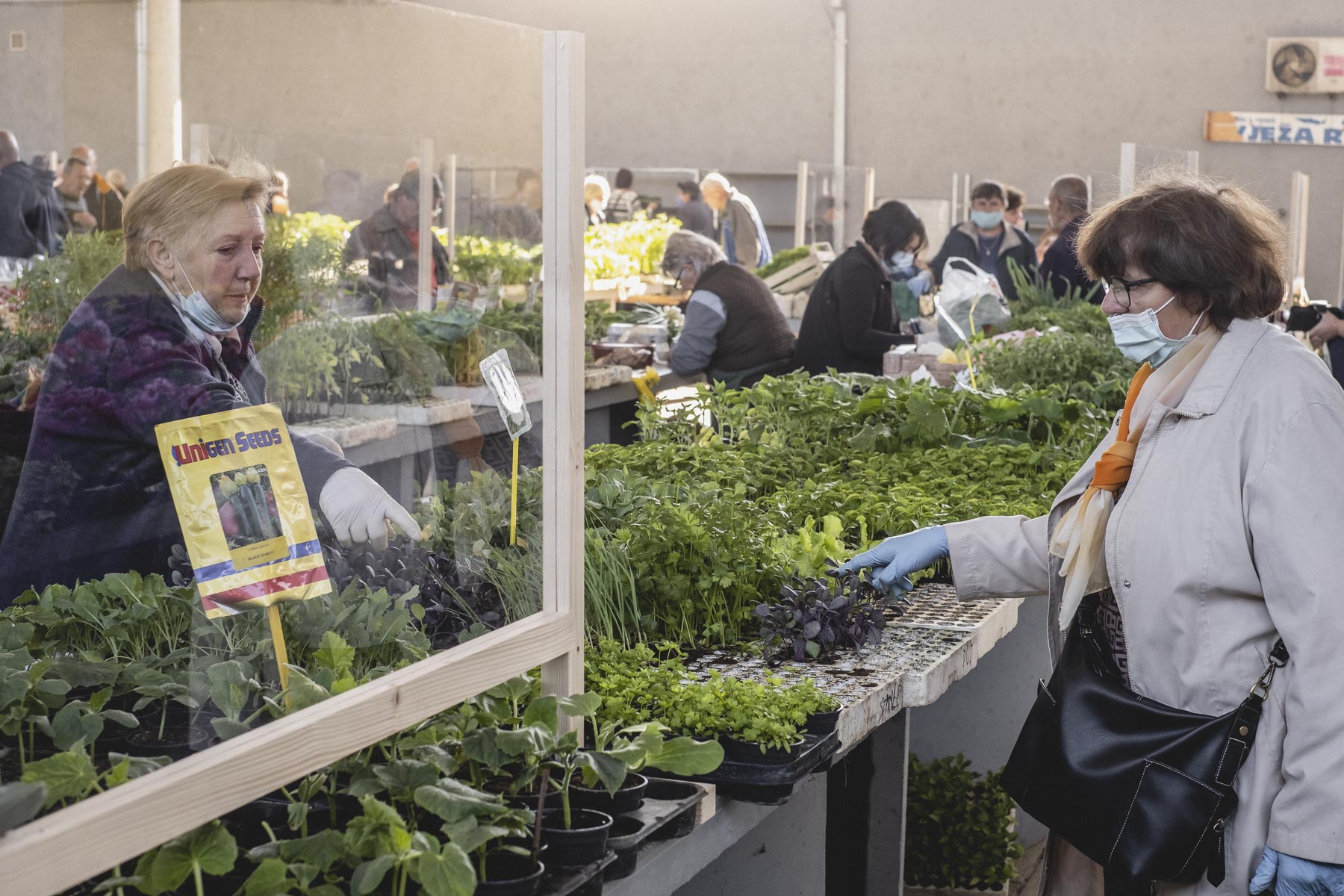
Joubert Loots visited the market in Đurđevac and told us information about every measure this market took. Besides the fact they had dedicated entry and exit points, the number of people inside was monitored - just like in every other store lately.
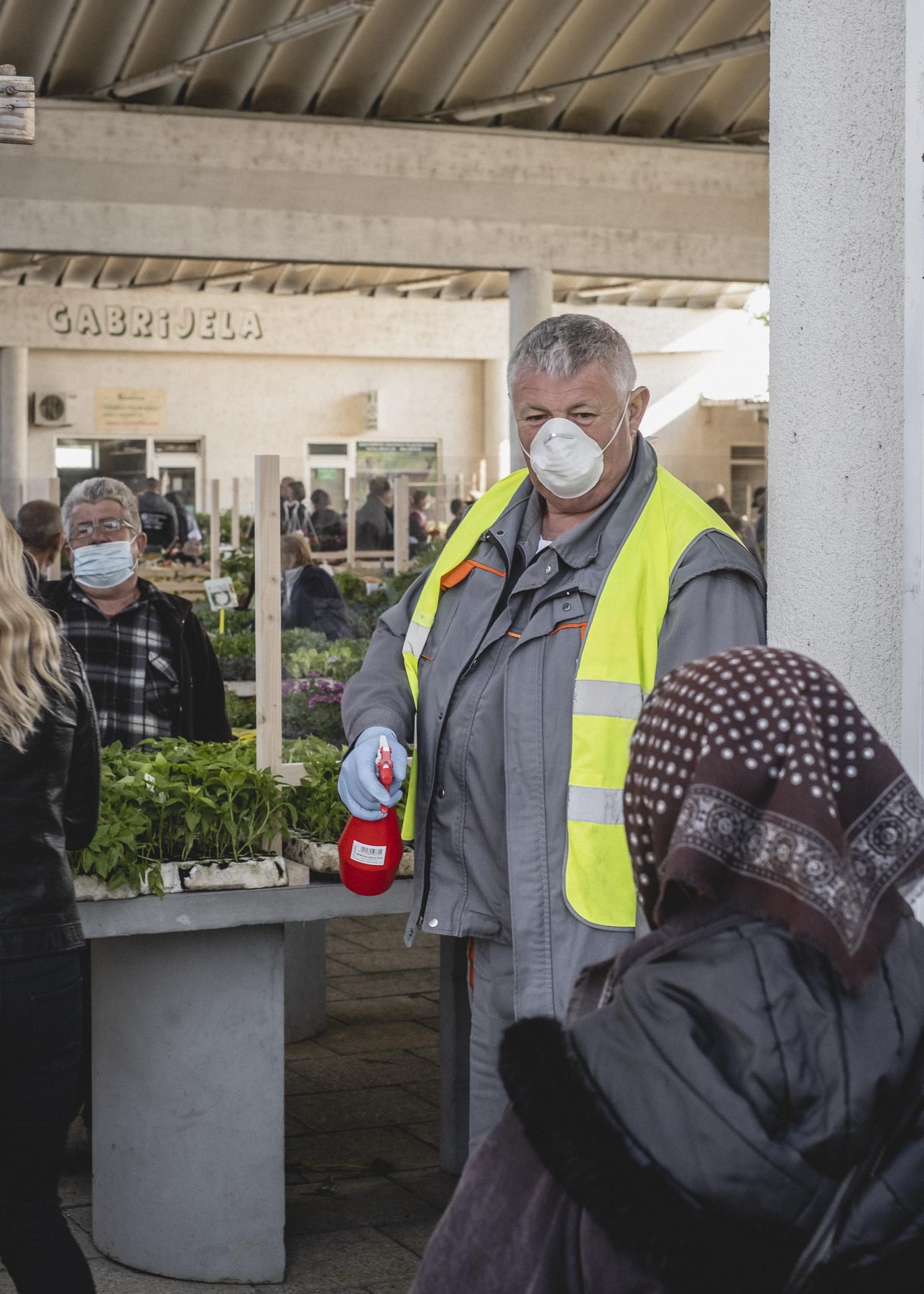
Most of the stalls had sneeze guards installed for added safety so you can sanitize your hands on every corner.
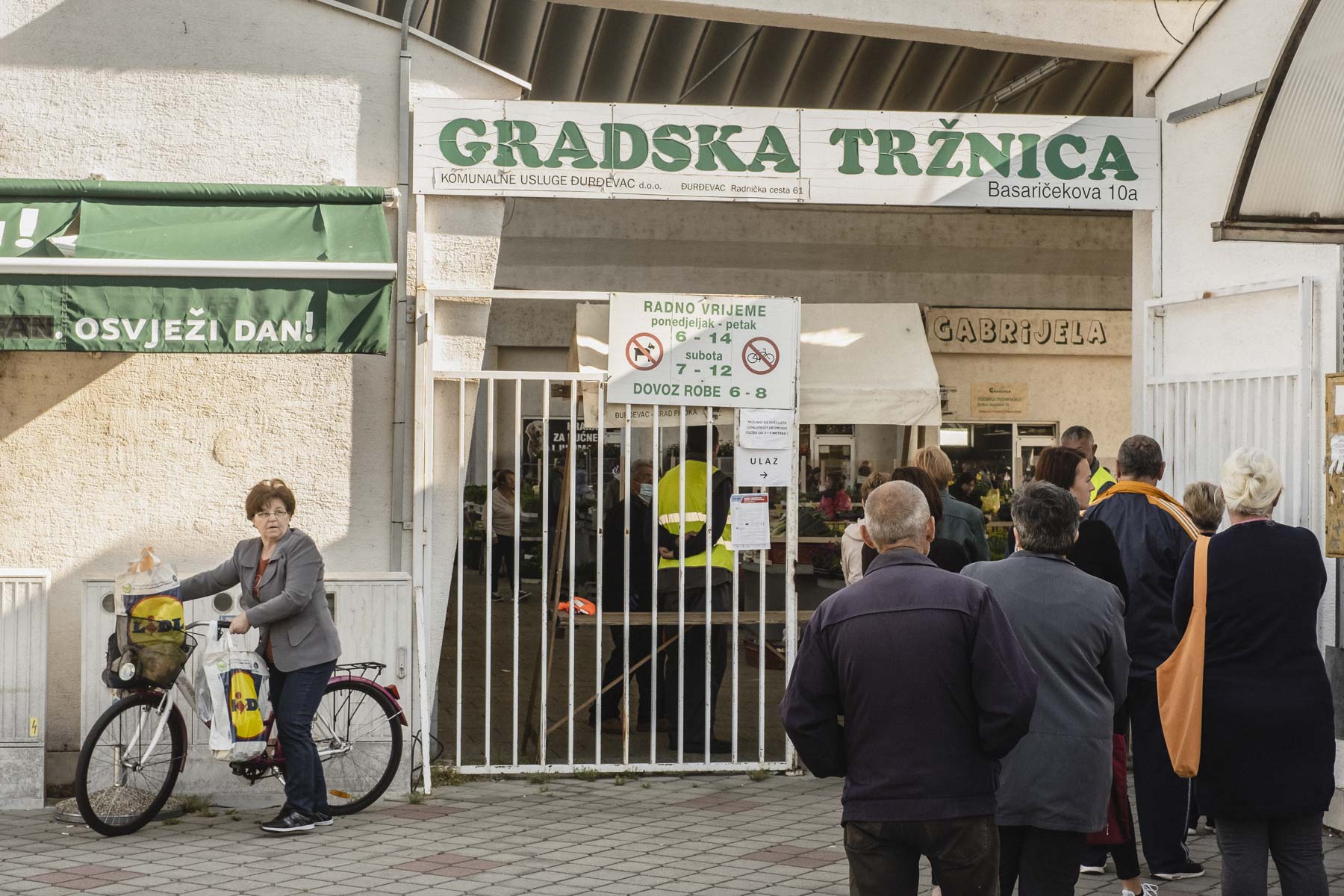
Maybe one of the best indicators that people from Đurđevac were missing their market was a long queue outside the market area.
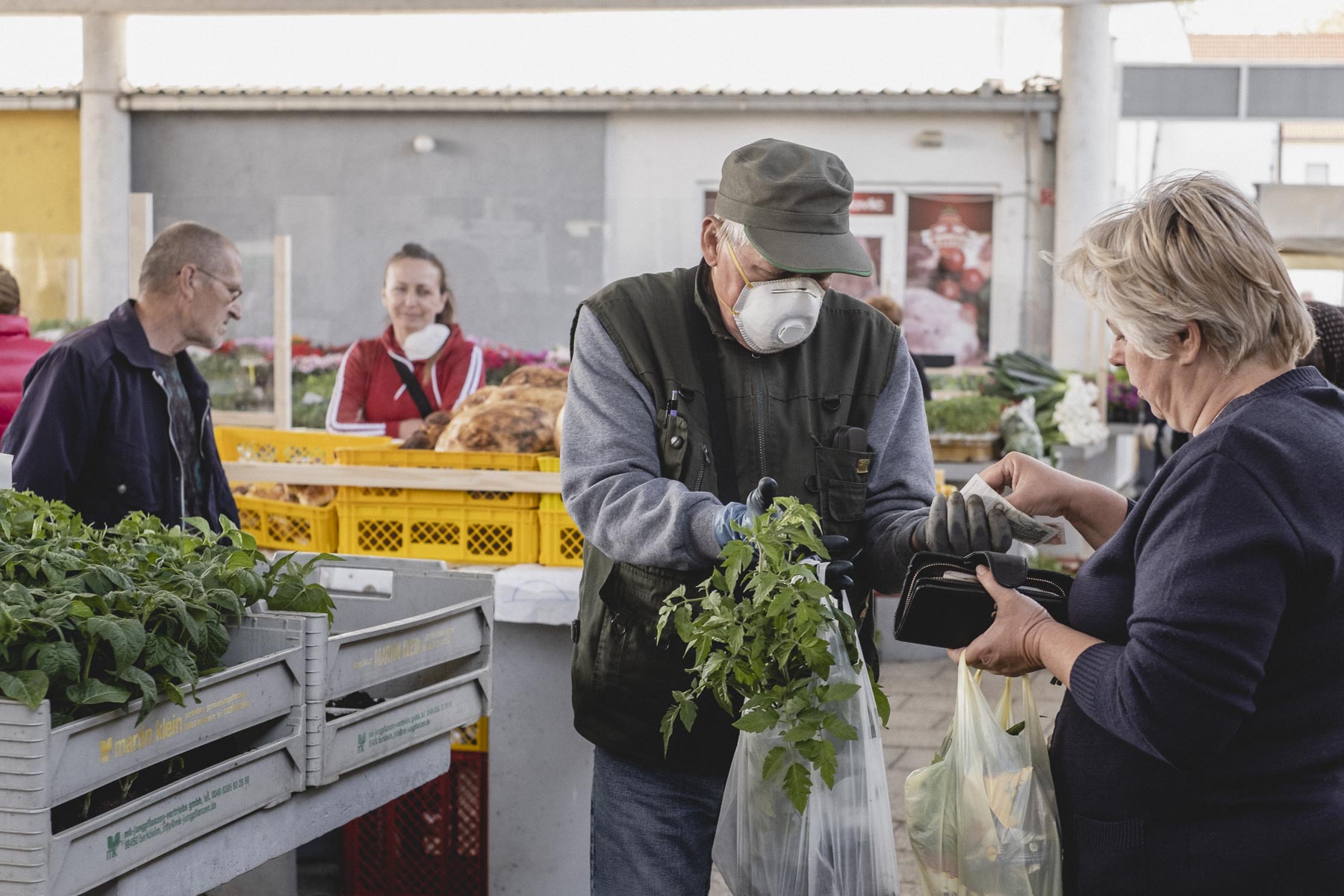
Although most people are still equipped with masks, gloves, and sellers with a partition between them and customers, life is slowly returning to normal.
Many thanks to Joubert for the submission. You can check out his portfolio of photography here.
Are you a small business in Croatia, which has just reopened after the recent lockdown? TCN is happy to support local businesses promoting their stories. If you are interested, please send photos, your experience, and your website to This email address is being protected from spambots. You need JavaScript enabled to view it. Subject Small Business.
For the latest news on COVID-19 in Croatia, follow the dedicated TCN section.
Discover Sveta Nedjelja on Hvar: Wine, Cliffs, Wedding Sunset Magic (VIDEO)
May 7, 2020 - Continuing our new vlog, TCN Talks, today we discover Sveta Nedjelja on the south side of Hvar - wine, wedding, rock climbing and sunset territory!
Where to go on a day off on Sunday on the island of Hvar? The village of 'Holy Sunday' of course...
Meet Sveta Nedjelja on the south side of Hvar in the latest installment of our new vlog, TCN Talks.
It is a village which is famous for the rich Plavac Mali wines produced from the very steep vineyards sloping down into the Adriatic, with Zlatan Otok's Plavac Mali Grand Cru one of the most highly-prized reds in all Croatia.
But there is a lot more to Sveta Nedjelja than just wine, as we discover sitting on the bench in idyllic Veli Kamik, the small islet which is fast becoming in an Instagram and wedding location hit (learn more about this delightful spot in our recent feature article on Veli Kamik).
And of course, to reach Sveta Nedjelja, you have to negotiate the Pitve tunnel
Here is a guide to the iconic tunnel's history, driving etiquette - and wine cellar.
Being to enjoy the idea of Bench Tourism? Here is a detailed overview of not only probably the best view in all Dalmatia, but also one which is extremely content-rich and full of magic.
And for those who like to wander, there are few better walks than that along the northern coast of Hvar, from Jelsa to Vrboska. Here is what awaits when you reach the place which is often called 'Little Venice.'
If you would like to follow TCN Talks and our random journey through life in Croatia, you can check out the channel here.
Looking to learn more about Hvar? All the best online tools are in our Virtual Croatia - Discover Hvar.
Source Claims Croatia Could Reopen Borders Incrementally in June
May 8, 2020 — Tourism Minister Gari Cappelli claimed yesterday requests from countries wanting Croatia to reopen its border this summer flooded his office. Their wish may come true.
A source consulting with the Civil Protection Directorate on reopening hospitality businesses said Croatia may start loosening border restrictions starting next month, adding the announcement may come as early as this afternoon.
Croatia could first reopen its border with Slovenia on June 1, followed by Czechia, Slovakia, Hungary, and Austria on June 15, the source said.
The reopenings would be subject to continued success in controlling the coronavirus, both within Croatia and the other countries.
Opening the borders would signal an unofficial end to the intense anti-pandemic measures Croatia put in place after its first confirmed affection arrived in late February. The country has already pulled back stay-at-home orders, and hospitality businesses will reopen next Monday.
It would also be one of the first countries to allow movement from other member states within the bloc. The European Union will apparently let members dictate border policy via bilateral agreements, rather than unified protocols.
The epidemiological measures and constraints weren’t clear, the source said, but would be presented in the announcement.
Border reopenings remain the last stage in Croatia’s transition to something resembling normalcy in the coronavirus era. The move signals the government’s hopes to salvage what’s left of the economically vital tourism season, which usually drives up to one-fifth of the nation’s GDP.
Cappelli said there were very few cancelations for July and August, suggesting the tourism season may bounce back better than expected
“Italians are still hoping to come to Croatia,” he said ahead of a government meeting in Zagreb yesterday. “Not to mention Slovenia, Austria, the Czech Republic.”
Croatia’s not alone in its desire to move past strict measures. Neighboring Slovenia is reportedly also seeking a way out of the current restrictions, hoping to rescue what’s been a complete loss on a summer tourist season.
The nation has also lobbied Croatia to cut back on travel restrictions for its citizens, many of whom own weekend homes along in Dalmatian. Opening the border for Slovenians would refill many empty houses on islands and along the coast, some of whom also offer accommodations during the summer.
Slovenia is also Croatia’s second-largest source of guests, accounting for 10 percent of overnight stays.
Italians remain off the radar in all discussions. The country’s coronavirus ordeal has statistically crested, and the government recently loosened some restrictions on daily life. But Croatia could be able to push back on opening the borders with Italy until August, when their tourists flood the coast.
Spas After the Corona Era: Are We Losing Our Healing Touch?
May 8, 2020 - Continuing Zoran Pejovic’s stimulating series looking at travel in the post-corona era, Melany Martinez of Paradox Hospitality turns her attention to the subjects of health and safety - how will spas look after the corona crisis?
Are high-tech therapy-providing machines and massage beds the future in our Spas, rather than human spa therapists? Are we losing our “healing-hands-touch-for-health” approach? Can machines really substitute the healing power of touch?
These kinds of questions come to mind after participating in various international forums where the wellness industry discusses how the spa world will look after the corona crisis.
Allow me to start from the beginning. My introduction to the world of wellness dates back to 1994 when I was 14 years old. I had just lost one of the most important people in my life to cancer, my grandfather. One day, a while after he passed, while I was looking through his library trying to choose a book to keep with me, I came across the famous book of Barbara Ann Brehnan, the Hands of Light.
When I saw the well-known image of the open hands holding a ball of light between them, I knew I was up to something. It was there and then that my life took a turn and from that moment on, I dedicated my life to learning various massage techniques and traditions. I was amazed by the emotional and physical effects after a massage, reiki, and other forms of complementary therapies. But this was already 25 years ago.
Fast forward to this century, and neuroscience has confirmed not only the vital importance of loving touch, but also its healing powers. Science has shown us the important role the sense of touch has in the psychological and cognitive development of the human brain. After all, our sense of touch is developed in our mother’s womb very early on, around the 7-8th week of pregnancy; by the 11th week, we are already feeling and exploring our environment and body.
In his book Touch: The Science of the Hand, Heart and Mind, bestseller, author, and researcher Dr. David Linden painfully remarks how a study conducted on a group of children wholly deprived of loving touch in the 80s and 90s in orphanages in Romania, developed not only psychological and intellectual difficulties but it was also found that their immune system was deeply underdeveloped.
Scientists agree that the immune system is stimulated and nurtured by touch. This does not change with age. In fact, according to lead Neurologist Dr. Hakan Olausson, author of Affective Touch and the Neurophysiology of CT afferents, the pleasantness of touch can be enhanced with age.
In other words, as we age, we appreciate the human (or animal) touch much more. Unfortunately, we tend to give and receive a less loving touch from our fellow humans as we get older. Let’s remember that our sense of touch is designed to recollect information around us, allowing us to bond and connect with each other. Social conventions are filled with gentle, confiding touch. Whether it is with your family, colleagues or friends, social conventions include touching as part of the interactions for a good reason: touch and trust are linked. Whether it is a professional shake of hands, a brief hug, or a deep embrace, when we touch (with the correct intention), we trust, and more often than not, we heal.
Technology and science have allowed us to study the sense of touch but not substitute it. In fact, technology and AI industries are working hard to incorporate the ability to sense textures and objects in their virtual reality platforms. However, even if we achieve this, there is an agreement in the neuroscience community, human contact is vital for our health, wellness and happiness.
So, as I mentioned earlier, science and technology have helped us understand why a hug feels so amazing, why after a good massage we feel so great, so light and relaxed.
However, can science and technology replace the actual human touch?
For me, the answer is no.
Before COVID-19, there was already a trend, even a push on the luxury hospitality sector, to introduce this type of equipment into Spa centers. Initially, the idea was to save costs. Spa operating costs are very high, many times, heated pools and wet areas take a good chunk of the costs, and as opposed to F&B outlets, human resources are limited to one-on-one service per hour! One therapist, one massage, one hour.
It seems hard to argue with the ability to cut costs when you compare a Spa that operates with 1 receptionist that takes care of 3 guests per hour, undergoing automated treatments, against a Spa that operates with 1 receptionist and 3 therapists providing 3 treatments per hour. How could you compete against that?
Well, first of all, looking at the spa services only from this perspective is missing out on all the other dimensions that compose a wellness experience: the intuitive touch of the therapists, the proficiency of their therapeutic technique, the empathic intention of the touch, and the healing environment.
So, if you are a small or medium day spa or hotel and you are worried about having to re-do your whole business plan, including buying fancy and expensive machines…take a deep breath and relax.
A machine cannot replace the intuitive knowledge, the fine-tuning of the therapist’s hands, the connection between the body and the therapist, where they seem to know exactly where to press, what stroke to give, when to combine this and that technique.
A machine cannot decide mid-way that the massage “protocol” needs to be adapted to me.
Knowing that massage reduces anxiety and enhances the immune system we, the therapists, managers, trainers and developers in the wellness and Spa industry, have a unique opportunity to contribute to the overall wellbeing of our communities by doing what we do best: caring, and caressing through our professional healing touch, providing and creating spaces of healing and transformation, helping our communities mentally and emotionally rebalance and reconnect.
Let’s continue nurturing our Spas and teams; let’s create and maintain spaces of transformation where our guests and clients can come and be embraced by the power of therapeutic touch.
We are all going to need a lot of tender-loving-care after these times. I strongly believe spas and wellness centers will thrive as we, humans, will always come back to the basics of our nature when in need of rebalancing and connecting: the loving touch.
When ready, open your doors, follow the recommendations of the experts, and spread your healing touch.
Enough with the fear, let’s start healing.
You can read more on this subject of post-coronavirus travel from Zoran here:
Tourism in the Corona Era: To Open or Not to Open, the Question is Now!
Travel Industry: Keep Communicating and Visibility
Build Scenarios! Be Present! Take Time to Think!
Post-Coronavirus Travel and Tourism: Some Predictions
Croatian Tourism 2020 and Coronavirus: Let’s Postpone the Season
Post-Corona Tourism Planning: Hope is Not a Good Business Strategy
Croatia: Territorial Claims in EU Unthinkable
ZAGREB, May 8, 2020 - Croatian Foreign Minister Gordan Grlić Radman on Thursday commented on Hungarian Prime Minister Viktor Orban's Facebook post of a Great Hungary map which includes a part of Croatia, saying the two countries had excellent relations and that territorial claims were unthinkable in the EU.
"Generally, any territorial claims in the European Union are unthinkable as all states recognised each other," Grlić Radman said, adding that "the border between Hungary and Croatia has always been known."
"The existence of historical maps which can be bought in an antique store, and not sought in a closet, doesn't reflect reality and, in a way, they divert attention from real life topics, which is building a future together."
The minister was referring to Croatian President Zoran Milanovic's condemnation of Orban's post in which he said that "Closets in most European countries keep similar contents hidden", calling on young people not to share such posts on social media.
Grlić Radman said Croatia and Hungary had excellent relations, as evidenced by the protection of each other's minorities and tourism, adding that Hungary had been among the first to recognise Croatia and that more than 50 Hungarians were killed in the Homeland War.
Orban has been extending best wishes to Hungarian students ahead of school leaving exams for several days now on his Facebook page and on Wednesday, before a history exam, he published a historical map of Hungary that includes portions of Croatian territory.
This map is frequently used in Hungary's popular culture, notably at rallies of the far right, and can also be seen on Hungarian cars during the summer in Croatia.
The map refers to the Kingdom of Hungary before the signing of the 1920 Treaty of Trianon, whereby Hungarians lost about two thirds of their territory. For that reason, they consider the peace treaty a national tragedy.
Orban posted the map in the past as well and during a previous term in office he declared June 4, the anniversary of the treaty, a day of national unity, according to Reuters.
His latest Facebook post, shared almost 1,000 times, has been criticised by many inhabitants of Romania as the Great Hungary map includes a portion of its territory too.
More news about relations between Croatia and Hungary can be found in the Politics section.
Milanović, Steinmeier Underline Importance of Solidarity in Europe
ZAGREB, May 8, 2020 - Presidents Zoran Milanović of Croatia and Frank-Walter Steinmeier of Germany said in a phone conversation on Thursday that cooperation and solidarity among European states were important in dealing with the coronavirus pandemic, Milanović's office said in a press release.
Croatia is currently presiding over the EU and Germany will follow it on July 1.
"The two presidents agreed that common European efforts are necessary to overcome this situation and that the success of the fight against the crisis caused by coronavirus will greatly impact Europe's future," the press release said.
After slowing down the spread of infection, both countries are gradually relaxing the restrictions imposed in mid-March. Croatia has confirmed 2,125 COVID-19 cases and 86 deaths, while Germany has confirmed 166,091 infections and 7,119 deaths.
More news about relations between Croatia and Germany can be found in the Politics section.
Plenković, Krstičević to Meet Today
ZAGREB, May 8, 2020 - Prime Minister Andrej Plenković and Defence Minister Damir Krstičević talked by phone on Thursday night and will meet on Friday, the government told Hina after Krstičević resigned over the death of two Air Force pilots.
Government spokesman Marko Milić told Hina the government "extends the deepest condolences to the families" of the two pilots killed in the crash of a military trainer aircraft near Zadar on Thursday afternoon.
The office of President and Armed Forces Supreme Commander Zoran Milanovic would not comment on Krstičević’s resignation on Thursday evening but it is expected that he will do so on Friday.
Croatian Peasant Party (HSS) president Krešo Beljak said on Thursday that by resigning, Krstičević did "the right thing for the first time in his term." He and the HSS extended their condolences to the pilots' families.
The chair of the parliamentary defence committee, Igor Dragovan of the Social Democratic Party, said on Thursday the resignation was a highly moral and responsible act by the man responsible for the functioning of the defence system.
Speaking to Hina, he said Krstičević was not responsible for the crash but that his resignation was honourable.
Živi Zid leader Ivan Sinčić said on Thursday Krstičević had shown a number of times during his term that it was more important to him to favour NATO, his former company KING ICT and the clients of his ruling HDZ party than soldiers' safety.
In a Facebook post, he extended his condolences to the pilots' families.
More politics news can be found in the dedicated section.
Exercise at Home Project by Croatian Football Federation Viewed Over Million Times
May 8, 2020 - The coronavirus pandemic may have temporarily stopped football, but it has not prevented footballers from exercising. The Croatian Football Federation offered video training to young football players daily, and after 35 published videos, the great success of the #vježbajdoma project is visible and easily measurable.
Through the #vježbajdoma (#exerciseathome) project, HNS wanted to encourage young football players to use their free time for physical activity and improve their abilities during this extraordinary situation.
Workout videos that can be performed at home, without additional devices and aids, were published daily, and among the videos were doctors' instructions on healthy eating as well as advice on a psychological approach to these unusual circumstances.
The video was created by Croatian senior and young national team members in football, fitness experts, coaches, coaches, and experts from other fields such as medicine and psychology, as well as several other football players from many clubs.
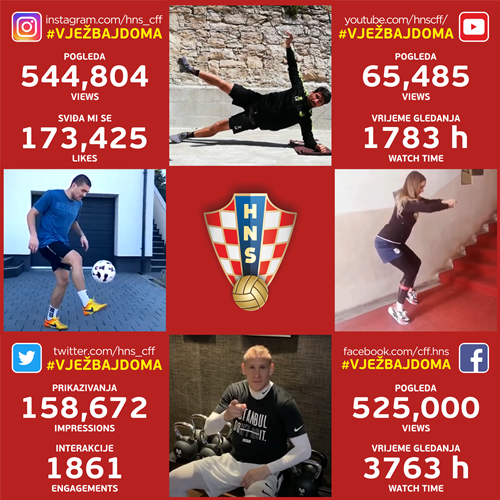
"From the bottom of my heart, I thank all those who participated in creating this training because we showed really great unity in wanting to bring the knowledge, skills and experience of top coaches and footballers to our large base. Many thanks to everyone who practiced with us. Finally, I would like to thank our video analyst Nikola Buzadžić, who put a lot of effort into editing these works that have lasting value for the HNS and young footballers. I am glad that in this way, we help athletes stay in shape, but I know that everyone can't wait to return to the football fields. I hope that the epidemiological situation in the country will allow us to do that relatively soon, and until then - we will continue to practice at home," said HNS chief instructor Petar Krpan.
The final figures are truly impressive. Thirty-five trainings were published on four HNS channels: YouTube, Facebook, Instagram and Twitter, with videos viewed more than a million times. On YouTube and Facebook alone, the total viewing time is more than 5,500 hours, and on Facebook and Instagram, the videos have garnered nearly 200,000 “likes”.
"We were aware that more than 100,000 young football players were left without daily training and we wanted to encourage them to exercise as much as possible at home, in a quality way. That is why we have included great fitness trainers from all parts of Croatia and I thank everyone for agreeing to share their knowledge via video. We have also included a number of our famous footballers, as well as indoor soccer players, to inspire further those who practice with us. All recorded training will remain available on HNS channels for everyone who wants to continue training according to such high standards," said Ivan Krakan, HNS fitness instructor for junior national teams, who initiated the project with chief instructor Krpan.
To read more about sport in Croatia, follow TCN's dedicated page.
Coronavirus: Dalmatia Wants to Relax Measures for Hospitality Industry
As Novac/Jozo Vrdoljak writes on the 7th of May, 2020, the third phase of easing the anti-coronavirus measures, which begins on May the 11th, will enable the operation of catering and hospitality facilities and only in outdoor areas and on terraces, while respecting the special epidemiological measures which continue to be firmly in place.
This is one of the reasons why the representatives of the catering and hospitality industry in the Professional Group of the Croatian Chamber of Commerce (HGK), more precisely the Split County Chamber, decided to hold an online session. The session discussed tax burdens and levies, the lease of public areas and business premises owned by the state and by local self-government units, unfair competition, a moratorium on credit indebtedness and other issues of importance for the functioning of this type of business in the coronavirus era.
For each of the aforementioned topics, concrete proposals and ways of dealing with things were provided at the session, and it was agreed that, depending on the issue, the group would send letters with their proposals to various institutions. These included the City of Split, the Croatian Employment Service (CES), the State Inspectorate, and via the national association to the Croatian Chamber of Commerce itself, and then even further - to the appropriate ministries and to the Croatian Government.
"Until the current requirements for the operation of catering facilities are relaxed, I'm of the opinion that the vast majority of those working in this sector will have neither the conditions nor the motives to start working again," said Ivan Malada.
Stipe Jelicic, Vice President of the Association of Catering/Hospitality Activities of the Croatian Chamber of Commerce, informed his colleagues about the proposal for the measures for the catering and hospitality industry from the aforementioned national association and the course of the negotiations with the National Civil Protection Headquarters regarding those same proposals in the hope of reaching a fair and favourable solution that suits everyone.
The group pointed out the various issues and problems created by the situation with the coronavirus pandemic in the catering and hospitality industry and proposed some solutions to those issues. At the very beginning of the crisis, the group sent their proposals for what the measures should look like to the City of Split and to Split-Dalmatia County.
"Regarding the beginning of operations for those in the catering and hospitality industry under these specific conditions, we've suggested to the State Inspectorate that their actions be primarily educational and preventive, with the aim of pointing out omissions, and if there are minor mistakes, the allowance for them to be corrected. That's why I'd like to invite those in this field to contact HGK ŽK Split directly if they have difficulties in organising their work in accordance with the decisions and instructions, in order to cooperate with the competent institutions in a constructive way to resolve misunderstandings and find solutions,'' stated Joze Tomaš, president of the Croatian Chamber of Commerce - Split County Chamber.
Make sure to follow our dedicated section for all you need to know about coronavirus in relation to Croatia.
How Will Cafes and Restaurants in Croatia Work from May 11? The Details
e May 8, 2020 - The Croatian Institute of Public Health published detailed recommendations for catering facilities in Croatia on Thursday morning as cafes and restaurants can re-open from Monday, May 11.
Index.hr reports that to prevent the spread of infection while visiting catering facilities with and without terraces, and catering facilities in accommodation facilities, it is necessary to ensure a physical distance between visitors and between visitors and employees.
Working hours from 6 am to 11 pm, and work will be allowed inside, as well
Organization of work: Working hours of catering facilities are possible from 6 hours to 23 hours. In the facilities, tables are kept empty until guests arrive, and utensils are served when guests sit down. Menus should be displayed at the entrance or another visible place, and in plastic, that is, classic forms of the menu should be removed. Visitors can be given a verbal recommendation, or something similar, to express the food and drinks offer.
Limit the total number of visitors: The limit on the number of visitors can be achieved by setting the tables 1.5 m apart. The entry of guests is regulated in such a way that the next visitor or group of visitors can enter only when the previous group of visitors leaves. The physical distance between individual groups of visitors must be at least 1.5 m. Tables should be arranged to maintain a physical distance of 1.5 m between the tables, or between different groups of guests. Organized groups of guests can sit at tables, and the distance between individual groups of guests in the facility must be at least 1.5 m. For example, members of one family sit 1.5 m away from another group of guests, even if it is a long table that is intended for seating multiple people.
Serving food and drink: Visitors can also order a meal or drink in the restaurant, which they will take with them and consume on the terrace or outdoors. When ordering, a physical distance of at least 1.5 m between customers waiting in line must be observed. It is possible to order and pick up food or drink at the bar without delay, i.e., you cannot stay at the bar. Also, it is possible to serve standing guests if they keep a physical distance, without high tables, with consumption by hand.
Employee that serves guests on the outside of the facility: One employee is appointed who serves a pre-determined number of tables to minimize the mixing of employees and guests. Between charging for the service and serving individual visitors, the employee must disinfect their hands.
Hotel policies
Special rules for catering facilities in accommodation facilities and others that serve buffet-style: In these facilities, it is recommended that visitors maintain a physical distance of 1.5 m during their stay, and especially when serving meals in a buffet manner, unless they are members of the same family when members of the same family don't need to maintain a distance during their stay in the restaurant. It is recommended that the buffet mode of serving be carried out so that there is a partition between the guests and the food and that one employee serves the guest's food according to their choice. Other measures of physical distance related to family or other groups of visitors who use the services in the group are the same as for all other catering facilities.
Health protection of visitors and staff; Refers to sales and staff service: Everyone should always have a disinfectant available to disinfect their hands periodically. If possible, it is recommended to provide a space of at least 1.5 m between the server or cashier and the customer when issuing goods and paying for goods, or if possible, install a protective barrier at the place of service and at the cash register, which will physically separate the cashier from the customer. Contactless payment by bank cards should be encouraged.
No handing out newspapers or serving snacks at the tables
Caterers should adhere to the highest hygiene standards and wash their hands with warm water and soap as often as possible with the use of hand sanitizer, certainly before serving guests to each new table. Adapted to the epidemiological situation, it is currently recommended that air conditioners be out of use and that the space be ventilated.
After the departure of each group of guests, the table, chairs, and other surfaces that the guests touched must be wiped with disinfectant, i.e., the tablecloths must be removed even if they are not visibly soiled.
It is forbidden to serve snacks in bowls, and salt/pepper, oil/vinegar, and other spices cannot be left on the tables, but new, previously washed or disinfected dishes are brought for each group of new guests.
The use of shared newspapers, magazines and other printed matter in catering establishments is prohibited.
Cleaning and disinfection of the space: At the entrance to the facility, visitors should be provided with a hand sanitizer dispenser and a clearly displayed notice that it is mandatory to disinfect hands when entering. Also, the entrance should clearly display a notice that it is mandatory to maintain a distance of at least 1.5 m between visitors and between visitors and staff. Door handles and handrails, handrail surfaces, and door edges on refrigerators, as well as other surfaces that are noticed to be frequently touched by customers, should be continuously wiped with alcohol-based disinfectant or other means according to the manufacturer's instructions.
Indoor areas where guests are staying should be regularly ventilated.
To read more about business in Croatia, follow TCN's dedicated page.

